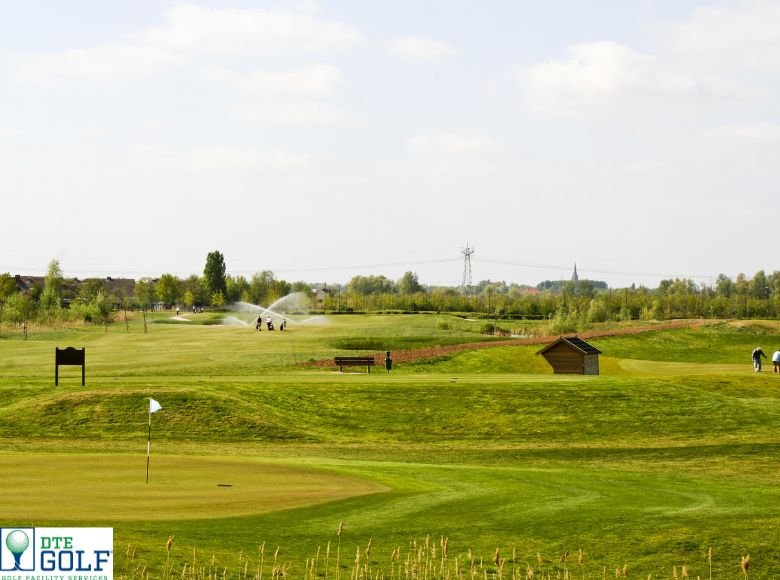Watering the Fairways: Best Practices for Golf Course Irrigation
Water is life, it is as simple as that. But watering your golf course isn’t a matter of “more is better”; it’s about getting the balance just right. In golf course irrigation, this balance transforms fairways into the vibrant, inviting landscapes we love, while also conserving resources benefitting both the course and the surrounding community.
Precise water distribution also helps turf thrive, promoting healthy root systems and reduce the likelihood of disease. By leveraging various advanced irrigation technologies, golf courses can optimise water use, making every drop count. This article covers best practices in golf course irrigation to achieve all of that for your golf course.
The importance of irrigation in Golf Course Management
Golf course irrigation has evolved into a sophisticated system which focuses on precise calibration and deep understanding of the turfgrass botany. Golf course management professionals know that the different areas of the course demand varying levels of attention and irrigation inputs. From putting greens to tee boxes , each of the zones on your estate presents unique irrigation challenges and requirements.
Understanding your turf's soil requirements, choosing grass that is appropriate for the local environment, and adjusting for weather patterns to prevent either overwatering or underwatering are all part of golf course maintenance .
Understanding Soil Dynamics for effective Golf Course Irrigation
The foundation of effective golf course maintenance starts below the surface. Soil composition directly influences how water moves through the ground and reaches grass roots. Smart golf irrigation systems account for:
Soil type and structure: Different soil compositions, from sandy loams to clay-heavy mixtures, require tailored irrigation approaches to ensure optimal water retention and distribution.
Water retention capacity: Understanding how long soil can hold moisture helps determine watering frequency and duration. This varies significantly based on soil composition and local climate conditions.
Drainage patterns: Proper mapping and management of how water moves through the course is essential for preventing waterlogging and ensuring consistent playing conditions.
Root zone depth: Different grass species have varying root depths, requiring customized irrigation strategies to ensure water reaches the entire root system effectively.
Topographical variations: Slopes, hills, and depressions all affect water movement and require specialized irrigation approaches to maintain uniform moisture levels.
1. Soil Management: A Key to Efficient Golf Course Irrigation
Soil management is foundational to any golf course. Different soil types have varying abilities to retain water, and understanding this helps in planning efficient golf course irrigation.
Types of Soils like sandy soils, for instance, drain quickly and may require more frequent watering than clay soils, which retain water longer.
Regular soil testing allows groundskeepers to adapt their irrigation schedules based on moisture retention.
To promote better water retention and reduce irrigation needs, many golf course managers apply organic matter to the soil. This enhances soil structure and helps prevent issues like runoff and compaction.
Aeration, a process that involves creating small holes in the turf, also improves water absorption, allowing more even distribution of moisture across the fairways.
2. Best Watering Schedules Practices during Golf Course Irrigation
An effective irrigation schedule for a golf course matches the natural cycles of the grass. Different parts of a golf course have different watering needs. Fairways need less water than greens and tees may require even less.
A zoned irrigation system allows the course manager to apply only the amount of water that is needed in each area, thus minimizing waste. According to golf course management professionals at DTE Golf®, irrigation is all about timing. Watering in the early morning hours (generally between 4 AM and 6 AM) produces results that are often considered the best, because:
Wind speeds are usually lower, allowing for more even water distribution and preventing drift onto unwanted areas.
Evaporation rates are minimal, ensuring maximum water absorption into the soil and root systems.
Play isn't disrupted, maintaining the course's revenue potential and player satisfaction.
Water pressure is optimal due to reduced general water usage in surrounding areas.
Grass has time to dry before peak playing hours, reducing disease risk and improving playability.
3. Choosing the Right Irrigation Technology and Equipment
Understanding which equipment is suitable is fundamental to an efficient and profitable golf course management program. Even though traditional sprinkler systems are still widely used in many courses, more sophisticated approaches are being employed like drip irrigation, and low-flow sprinklers. These systems irrigate water more directly to the root zones of the grass which results in higher water absorption and less runoff.
Additionally, modern golf irrigation systems incorporate advanced technologies that allow super precise amounts of water to be dispensed exactly where and when it is needed. Course superintendents are now able to control:
Weather-based control systems: Advanced systems that automatically adjust watering schedules based on real-time weather data and forecasts, ensuring optimal water usage.
Soil moisture sensors: Sophisticated probes that provide real-time data about moisture levels at various soil depths, allowing for precise irrigation adjustments.
Mobile monitoring applications: Modern apps that enable superintendents to control and monitor irrigation systems remotely, providing unprecedented flexibility in golf course management.
GPS-guided sprinkler systems: Precision technology that ensures accurate water distribution and helps eliminate dry spots or over-watered areas.
Flow management tools: These are the advanced systems that monitor and adjust water pressure and flow rates to maintain optimal distribution across the entire course.
4. Water Conservation Strategies for Efficient Golf Course Irrigation
Today, golf courses are certified by organizations such as Audubon International, which promote environmentally sound management practices for golf courses. Sustainable irrigation practices benefit the environment, golfers, and course managers.
The aim of golf course irrigation is not solely conservation, but smart optimisation. Some of the best ways to go about this include:
Cycle and soak methods: Breaking up watering times into smaller intervals to improve absorption and reduce runoff.
Deep and infrequent watering: Encouraging deeper root growth and stronger turf by watering thoroughly but less often.
Accurate placement of sprinkler heads: Placement of the sprinkler heads in such a manner that complete coverage is achieved with minimum waste.
System audits: These are ascertaining the performance and efficiency of the irrigation system through detailed and prompt evaluations.
5. Weather Adaptation in Golf Course Irrigation
Weather patterns are unpredictable, and this is where weather-adaptive technology becomes invaluable in golf course irrigation. Advanced ET (evapotranspiration) monitoring systems help you precisely control various aspects. Golf courses also have distinct water requirements depending on the season, and advanced irrigation systems adjust accordingly to support the turf’s changing needs.
Summer Requirements
During the summer, the turf faces higher evaporation rates and increased water demands. To meet these needs efficiently, courses typically employ:
Water application rates of 0.15 to 0.25 inches per cycle, tailored to keep the soil adequately moist without overwatering.
Triple cycle-soak method to improve absorption, applying water in shorter, repeated bursts to prevent runoff and encourage deep root growth.
Pre-dawn watering windows (3:00 AM - 6:00 AM) to reduce evaporation and allow water to penetrate the soil deeply before the day’s heat sets in.
Winter Adjustments
In winter, when the turf requires less hydration, the irrigation system adjusts to minimize water use while protecting the course from frost damage and soil freezing. Seasonal modifications include:
Reduced watering to about 0.5 to 0.75 inches weekly, ensuring turf health without saturating the soil in cooler temperatures.
Soil temperature-based programming which triggers irrigation only when soil temperatures indicate that additional moisture is necessary.
Modified pressure settings for frozen ground prevention, helping avoid system damage and ensuring the water penetrates the turf slowly and steadily in lower temperatures.
Top-Notch Golf Course Irrigation with DTE Golf®
There's no need to do a rain check again! At DTE Golf®, we understand the art and science of watering the fairways. We guarantee that every square inch of your course receives the hydration it requires to be healthy and playable when you use DTE Golf®.
Are you prepared to upgrade your irrigation techniques for golf courses? Regardless of the season, we assure that our expertise will support you to keep your course green, effective, and in top condition!

